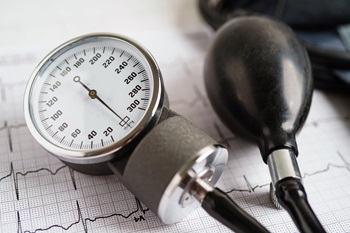STUDY REVISITS INTENSIVE BLOOD PRESSURE STRATEGY IN DIABETICS
Recent study finds a benefit, contradicting results from a previous trial
Straight Healthcare
December 2024
December 2024

In 2010, the ACCORD study (N=4733) was published, which found that an intensive blood pressure treatment strategy (target systolic blood pressure [SBP] < 120) did not significantly improve cardiovascular disease (CVD) outcomes compared to a standard strategy (target SBP < 140) in diabetics with hypertension. However, subsequent large trials showed that lower SBP targets (<120-130) improved CVD outcomes across a broad range of patients with and without diabetes. Given the discrepant findings, researchers decided to revisit the issue in diabetics by performing the BPROAD study, where 12,821 hypertensive type two diabetics at increased risk of CVD were randomized to an intensive (target SBP < 120) or standard (target SBP < 140) blood pressure treatment strategy; average SBP one year into the study was 122 mmHg in the intensive group and 135 mmHg in the standard group. After a median follow-up of 4.2 years, a composite of CVD events was significantly lower in the intensive group (1.65%/year vs 2.09%/year, p<0.001). [BPROAD abstract]
Contrary to the 2010 ACCORD trial, BPROAD found that a lower SBP target was beneficial in diabetics with hypertension. Possible reasons for the contradictory findings include (1) lower power in the ACCORD study due to a smaller sample size and (2) the ACCORD study design, which included another factor where patients were randomized to intensive (HgA1C < 6%) or standard (HgA1C 7 - 7.9%) glycemic targets. Other large studies, summarized below, have found that lower SBP targets modestly reduce the absolute risk of CVD events by 1 - 2% in a broad range of patients. While this effect size is small, it is meaningful when applied to large populations. Collectively, these studies support a target SBP of less than 120 mmHg in patients who can tolerate it.
Contrary to the 2010 ACCORD trial, BPROAD found that a lower SBP target was beneficial in diabetics with hypertension. Possible reasons for the contradictory findings include (1) lower power in the ACCORD study due to a smaller sample size and (2) the ACCORD study design, which included another factor where patients were randomized to intensive (HgA1C < 6%) or standard (HgA1C 7 - 7.9%) glycemic targets. Other large studies, summarized below, have found that lower SBP targets modestly reduce the absolute risk of CVD events by 1 - 2% in a broad range of patients. While this effect size is small, it is meaningful when applied to large populations. Collectively, these studies support a target SBP of less than 120 mmHg in patients who can tolerate it.
- SPRINT trial (2015): The SPRINT trial (N=9361) compared a target systolic blood pressure (SBP) of <120 mm Hg to a target of <140 mm Hg in nondiabetic individuals at increased risk of CVD. The lower target reduced the incidence of a composite of CVD events by 1.6% over a median follow-up of 3.26 years (5.2% vs 6.8%, p<0.001). [PubMed abstract]
- STEP study (2021): The STEP study (N=8511) compared a target systolic blood pressure (SBP) of <130 mm Hg to a target of <150 mm Hg in Chinese patients 60 to 80 years old with hypertension. The lower target reduced the incidence of a composite of CVD events by 1.1% over a median follow-up of 3.34 years (3.5% vs 4.6%, p=0.007). [PubMed abstract]
- ESPRIT study (2024): The ESPRIT study (N=11,255) compared a target systolic blood pressure (SBP) of <120 mm Hg to a target of <140 mm Hg in Chinese patients at high risk for CVD. The lower target reduced the incidence of a composite of CVD events by 1.4% over a median follow-up of 3.4 years (9.7% vs 11.1%, p=0.028). [PubMed abstract]
- Hypertension treatment guidelines
